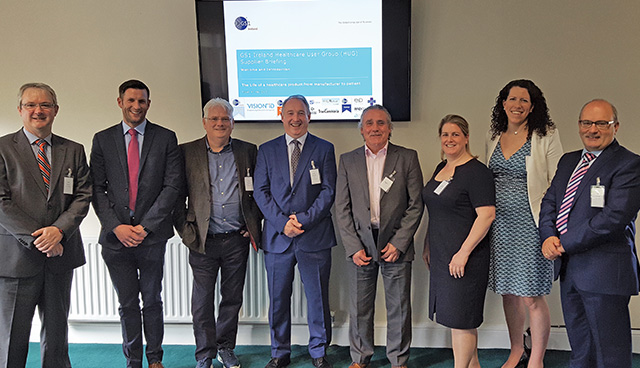The life of a product: from manufacturer to patient


The HSE hosted the GS1 Ireland Healthcare User Group (HUG) Supplier Briefing on Friday 4 May 2018 in the Boardroom of HSE, Dr Steevens’ Hospital. The event was very well attended with nearly 100 delegates representing medical device suppliers and manufacturers as well as healthcare providers.
The Healthcare User Group (HUG) Supplier Briefing focused on the life of a medical device product as it travels from manufacturer to the patient. Shay Farrelly, a haemophilia patient, spoke about the challenge faced by fellow patients to regain trust in the supply of medication after the hepatitis and HIV contamination scandal. Today, they have a world-class track-and-trace solution that identifies, manages and records their medication. A key feature of the solution is a phone app that enables patients to scan and record their medication at the point of care. Not only does this check and validate the treatment, but additionally informs their clinical care record, which leads to benefits for patient safety, efficiency and better-quality care.
The theme of traceability was referenced throughout the morning. The second speaker, John Swords, Head of Procurement HBS, HSE, confirmed the importance of unique identification to enable the implementation of the Electronic Health Record as well as the IFMS (Integrated Financial Management System) which is currently a major part of the HSE work programme.
“Track-and-trace is where we want to be going as part of the IFMS and EHR rollout. This is key for patient safety,” says Swords, who confirmed that the GS1 Unique Identifier is part of many current HSE programmes, including the Individual Health Identifier (IHI).
Manufacturers selling medical devices in Europe will be required to register their device information in the EUDAMED database by 2020; and from 2021 devices will be required to have a UDI barcode on the product packaging. The labelling of devices will be introduced in a phased approach, similar to the US FDA regulation, starting with Class III devices. The regulation will require manufacturers to include the UDI in the Field Safety Notices and recall notices being provided to the regulatory bodies in each country.
Ronnie McDermott, HSE Medical Equipment Management Lead confirmed the importance of the UDI for managing both medical equipment and medical devices during his presentation. “RFID tags with 2D Datamatrix Barcodes are being rolled out as the standard asset identifier for all medical equipment across the HSE, for improved and enhanced patient safety,” he explains.
The role of the manufacturer and distributor is vital in delivering UDI compliant products to the market. Declan O’Reilly from GS Medical and Maria Svejdar from GS1 Ireland presented an overview of how to get started with UDI barcoding.
“Traceability is key, not just for our internal processes but most importantly for track and trace of products to the patient,” outlines O’Reilly.
The EU UDI regulation also includes a requirement for healthcare providers to capture and store the UDI in their systems, preferably electronically, starting with Class III devices.
“The best unique identifier is the barcode and we see this as the single most reliable piece of information,” emphasises Swords, who spoke about the work being done in the National Distribution Centre (NDC) to standardise information using the UDI/GTIN (Global Trade Item Number) as the unique identifier in the HSE systems. This will support compliance to contracts and traceability of product to the patient. Collaboration with suppliers is a key part of this work and the audience were invited to work with the HSE to support the standardisation of coding and data.
All presentations are available on the GS1 Ireland website.
About GS1
GS1 licences the most widely-used system of supply chain standards, serving more than 2 million public and private sector organisations worldwide.
For more information:
Mike Byrne, CEO or Siobhain Duggan, Director of Innovation and Healthcare,
GS1 Ireland
T: 01 208 0660
E: healthcare@gs1ie.org
W: www.gs1ie.org/healthcare






